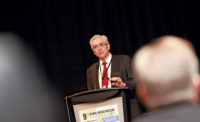With the May 17 release of President Bushs task force report on energy policy, the issue has moved to the front burner. Bush moved quickly to implement some of the panels 105 recommendations, and Congress is beginning to wrestle with legislation dealing with other parts of the plan. The drive to produce an energy bill this year seems to have some steam on Capitol Hill, but Democrats strong position guarantees the President wont get all he wants from Congress. Moreover, decisions on many issues that affect constructionsuch as siting and financing more refineries, powerplants, transmission lines and pipelinesrest more with local officials and the private sector than the federal government.
Things are beginning to move. On May 18, Bush signed two executive orders recommended in the task force report. One directs agencies to expedite reviews of permits for "energy-related projects." The other mandates that a "statement of energy effects" be included in all new major federal regulations.
The congressional debate has begun. The Senate Energy and Natural Resources Committee was scheduled to start hearings May 23 on the Bush program. Panel Chairman Frank Murkowski (R-Alaska) hopes to have a broad-based energy measure out of committee by mid-June and on the Senate floor soon after that. "Were going to mark it up. Were going to move it out," he says.
In the House, Energy and Commerce Committee Chairman Billy Tauzin (R-La.) plans to work on several smaller bills, each focusing on a piece of the energy program. He wants to begin with an energy conservation measure.
 |
CHALLENGES. The task force sees major problems. "America in the year 2001 faces the most serious energy shortage since the oil embargoes of the 1970s," it says. Among the nations key challenges are using energy "more wisely," fixing and expanding infrastructure, boosting energy supply without harming the environment and promoting U.S. energy security.
Besides the executive orders Bush signed, the panels recommendations include many other items that affect construction (see table). Engineers and constructors are strongly upbeat about the plan. "This is the first time that weve had the opportunity to have public debate in the U.S. about what the policy should be," says Leonard Rodman, chairman, president and CEO of Kansas City-based Black & Veatch.
Rodman welcomes the attention to the electricity grid. "The transmission system in the U.S. is really a weakness," he says. Noting that President Eisenhower pushed the Interstate Highway System to ease troop movement for national defense, Rodman sees a need for a national transmission system to secure the countrys power supply.
"The transmission infrastructure throughout the U.S. has not been kept up," agrees William S. Skibitsky, CEO of myr Group, Rolling Meadows, Ill., a builder of power-delivery systems. As the system was neglected, the market for transmission-line equipmentpullers, tensioners and sheave blockscontracted, he says. "Theres going to have to be a rebirth in the equipment industry."
CRITICISM. Environmental groups criticized the plan. David M. Nemtzow, president of the Alliance to Save Energy, says the program "provides lip service to energy efficiency and saves all its heavy lifting for increasing energy supplies."
It is clear that some of Bushs recommendations are too controversial to make it into a final legislative package. Senate Minority Leader Tom Daschle (D-S.D.) says the proposal to drill in the Arctic National Wildlife Refuge is dead on arrival and contends the Bush plan doesnt provide enough relief for short-term problems. Fellow Democrat Harry Reid of Nevada says eminent domain for transmission lines is "a non-starter."
Nevertheless, lawmakers see areas where both sides agree. "Im optimistic that we can pass something," says the Senate energy panels top Democrat, Jeff Bingaman of New Mexico. Glenn English, National Rural Electric Cooperative Association CEO, agrees: "I dont think theres any question that theres going to be a bill." English, a former 10-term congressman, thinks the big question is whether Congress will focus on specific industry needs and what it "can actually pass that the President will sign into law. And that starts narrowing it down very rapidly to a few very key points." One such point, he says, will be "tax incentives to encourage conservation."
Alden Meyer, the Union of Concerned Scientists government relations director, foresees "a lot of Sturm and Drang" in Congress, adding: "In the end, they may well produce a mouse."
Skibitsky admits that "there are a lot of roadblocks and hurdles, and its not going to happen in the short term." But on the whole, the Bush proposal balances emphasis among different types of energy infrastructure, he says. "It looks to me like a blended strategy," Skibitsky says.


Post a comment to this article
Report Abusive Comment